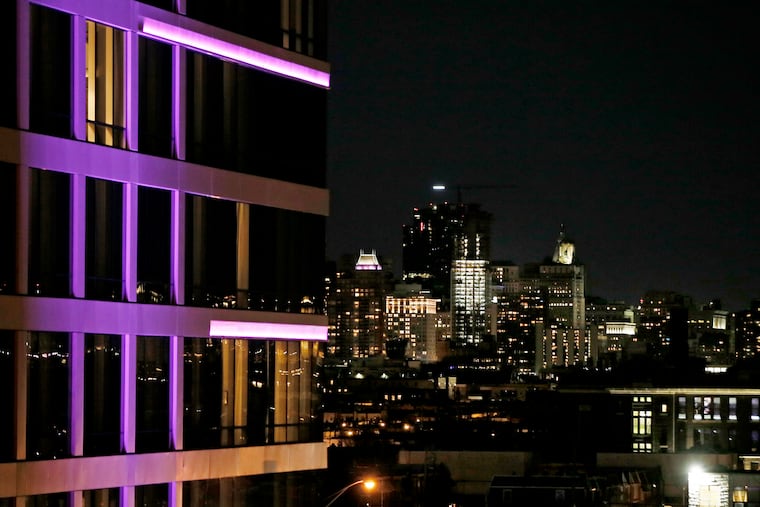Philly skyline will go mostly dark at night starting April 1 in an effort to save birds
Most migrating birds fly at night, and they can become disoriented by artificial lights, causing them to collide with buildings or windows. The lights also throw birds off migration paths.

Some of Philadelphia’s most iconic skyscrapers, such as the Comcast towers, BNY Mellon Center, and the Liberty Place buildings will soon go dark overnight as their owners take part in a program to protect migrating birds from being lethally drawn to the lights.
The new voluntary program, called Lights Out Philly, is an effort to prevent bird deaths as they migrate north in the spring and south in the fall, with most flying at night. Birds can become disoriented by artificial lights, causing them to strike buildings or windows. The lights also throw birds off migration paths, leaving them exhausted and confused, and vulnerable to various other threats.
A dozen other building operators or owners in Philadelphia also have pledged support for this effort including Brandywine Realty Trust, the city’s largest commercial landlord; Jefferson Center; One South Broad, and 1515 Market St., according to an announcement of the program.
The city’s skyline will go dark only from midnight to 6 a.m. However, experts say that will still save many from perishing, such as during an Oct. 2 event when an estimated 1,000 to 1,500 birds flew into buildings in a 3½-block radius of Center City overnight. One Audubon volunteer, Stephen Maciejewski, told The Inquirer at the time that it was a “perfect storm” of avian calamity, and suggested thousands more likely perished elsewhere in the city.
An Inquirer news story on that event, as well as a follow-up opinion piece, spurred the collaborative effort among the Academy of Natural Sciences of Drexel University, Delaware Valley Ornithological Club, Audubon Mid-Atlantic, and the Valley Forge and Wyncote local Audubon Society chapters. Its resulting Bird Safe Philly program is endorsed by the city’s Office of Sustainability, the Building Owners and Managers Association Philadelphia, and the Building Industry Association of Philadelphia.
The first season of Lights Out Philly launches April 1, at the start of peak spring migration, and runs through May 31. The next season runs Aug. 15 through Nov. 15 as birds travel south.
During those periods, participating building owners will turn off lights at the top of buildings known as crowns, facades, atriums, and lobbies. They’ll also ask tenants to voluntarily turn off interior lights.
Lennon Chandler, with the Audubon’s Atlantic Flyway program, said that although birds obviously fly before midnight, the Lights Out program is a “huge step that will help significantly minimize collisions.”
Keith Russell, manager of Audubon Pennsylvania’s Urban Conservation program, said Philadelphia is in a major migratory path of the Atlantic Flyway along Eastern North America “that’s used by hundreds of millions of birds each year,” and he estimates “tens of millions” of those pass through the city.
The goal is as much darkness as possible, said Kristine Kiphorn, executive director of the Building Owners and Managers Association, though there might be pockets of light for tenants with all-night operations.
Birds getting killed while migrating through the city is not new, dating as far back as 1896 after the lighting of City Hall. However, Kiphorn said there has been no coordinated effort to address the issue until now.
“We want to be part of the solution in preserving the bird population,” she said.
» READ MORE: Philadelphia’s glass skyline is killing birds. A new Fairmount Park building has a solution. | Inga Saffron
Organizers believe the number of participating building owners and operators will continue to grow after the start in April as Kiphorn’s organization and others continue to reach out to members.
Christine Knapp, director of Philadelphia’s Office of Sustainability, said the effort not only will save “countless birds” but also will save energy and reduce carbon emissions in line with meeting the city’s goal of achieving carbon neutrality by 2050.
Philadelphia joins 33 other cities in the Lights Out program, which started in 1999 in Chicago.
“We are heartened by all the efforts in our community to join together in this critical initiative to save so many birds from unnecessary harm and even death,” said Scott Cooper, president and CEO of the Academy of Natural Sciences. “A simple thing like turning out lights can help thousands of birds safely navigate our challenging urban environment.”
Maciejewski, who volunteers to count dead birds each morning and first discovered the Oct. 2 mass kill, called Lights Out Philly “a monumental first step” but said reflective glass remains a problem because it draws birds even when not illuminated.
“We also need to use bird-friendly glass in new construction,” he said.
City Councilmember Katherine Gilmore Richardson, who introduced the resolution for Lights Out Philly, said her office is reviewing material on more bird-friendly construction.
And Jamal Johnson, vice chair of the Buildings and Managers Association, said there is “a concerted effort in new construction to build in bird migratory safeties. ... There is definitely an awareness.”